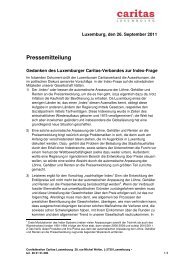Sozialalmanach - Caritas Luxembourg
Sozialalmanach - Caritas Luxembourg
Sozialalmanach - Caritas Luxembourg
You also want an ePaper? Increase the reach of your titles
YUMPU automatically turns print PDFs into web optimized ePapers that Google loves.
linking the amount of benefits received to income or means-testing from the top 24 , taking<br />
back transfer payments from those less in need via the tax system, and so on. Alongside<br />
these strategies of “vertical” targeting based on economic resources a trend is also observable<br />
towards “horizontal” targeting based on social risk: reducing the generosity of some core<br />
transfer programs (old age, disability and survivor pensions, for example) while increasing<br />
family benefits; introducing new subsidies for caregivers or categories with special needs, or<br />
expanding programs against social exclusion. Despite the above-mentioned “crowding-out<br />
effect” of established programs, some policy adaptations to the new structure of risks and<br />
needs have indeed taken place in a number of countries 25 . Great Britain, where income<br />
guarantees and unemployment benefits are modest, has, over the past decades, shifted to<br />
work conditional tax credits to support low-wage workers and their families. In Continental<br />
Europe, the main problem is that heavy social contributions price less productive workers out<br />
of the market. In the face of the relative weakening of traditional male breadwinner social<br />
insurance programs, policy makers in these countries have turned towards strengthening<br />
minimum income protection functions of the welfare state, coupled with strong activation<br />
and reintegration measures. This is also captured by the shift from out-of-work benefits to<br />
in-work benefits in many European countries. Access to benefits has been generally made<br />
more restrictive and conditional, but at the same time new networks of public and private<br />
employment services have been set up in order to promote and facilitate the labour market<br />
re-integration of workers without jobs. The 2005 Hartz IV reforms in Germany stand out<br />
as a case in point, involving a drastic shortening duration of benefits, tighter requirements<br />
to accept suitable jobs, simplification of insurance regulations, wage insurance for elderly<br />
unemployed, and the merger of unemployment assistance and social assistance.<br />
In the area of old-age pensions, the most important trend is the development of multipillar<br />
systems, combining PAYGO and fully funded methods with a tight actuarial link<br />
between pension benefits and contributions. The common thread is the shift toward defined<br />
contributions and changes in the assessment of pension accruals, together with postponing<br />
the retirement age. Sweden and Italy have fundamentally altered the architecture of their<br />
system, promoting “paradigmatic” change. Most countries tough have kept within the<br />
boundaries of “parametric” reform, moving within the logic of existing systems and<br />
taking steps in one or more of these directions: increasing the age of retirement, tightening<br />
qualifying conditions, restricting indexation rules or strengthening the link between<br />
contributions and benefits. Another important common trend in this area has been the<br />
growth of occupational and private pensions, giving rise to “multi-pillar” systems combining<br />
24 Kuhnle (2000).<br />
25 Armingeon & Bonoli (2006); Taylor-Gooby (2004).<br />
158








